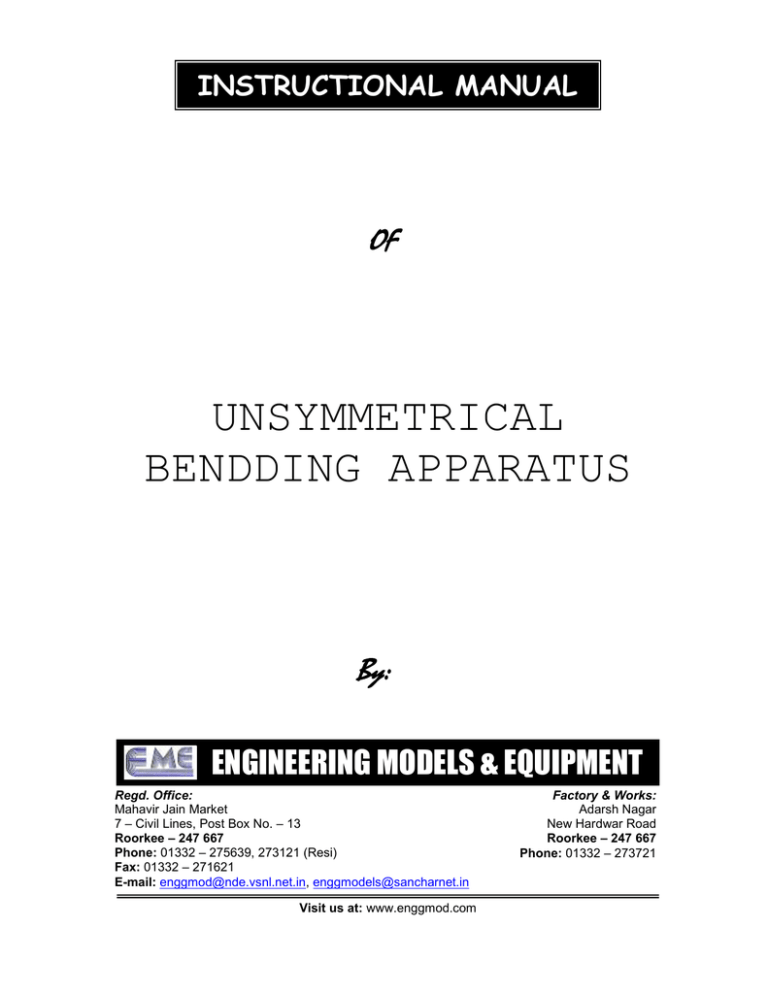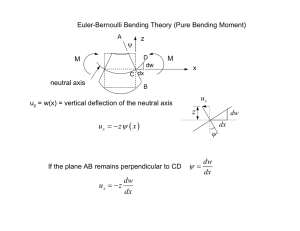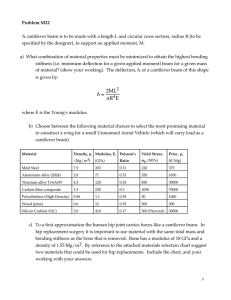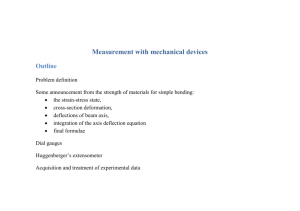Unsymmetrical Bending Apparatus
advertisement

INSTRUCTIONAL MANUAL OF UNSYMMETRICAL BENDDING APPARATUS By: ENGINEERING MODELS & EQUIPMENT Regd. Office: Mahavir Jain Market 7 – Civil Lines, Post Box No. – 13 Roorkee – 247 667 Phone: 01332 – 275639, 273121 (Resi) Fax: 01332 – 271621 E-mail: enggmod@nde.vsnl.net.in, enggmodels@sancharnet.in Visit us at: www.enggmod.com Factory & Works: Adarsh Nagar New Hardwar Road Roorkee – 247 667 Phone: 01332 – 273721 UNSYMMETRICAL BENDING APPARATUS CONTENTS: Page No. 1.0 Theory 03 2.0 Objective 06 3.0 Apparatus 06 4.0 Suggested experimental work 06 5.0 Results & Discussions 06 6.0 Sample Data Sheet 06 7.0 Precautions 07 UNSYMMETRICAL BENDING APPARATUS 1.0 THEORY: A member may be subjected to a bending moment, which acts on a plane inclined to the principal axis (say). This type of bending does not occur in a plane of symmetry of the cross section, it is called unsymmetrical bending. Since the problem related to flexure in general differs from symmetrical bending, it may be termed as skew bending. MY is that the I plane of the load is perpendicular to the neutral axis. Every cross-section has got two mutually perpendicular principal axis of inertia, about one of which the moment of inertia is the maximum and about the other a minimum. It can be shown that a symmetric axis of cross-section is one of the principal axis and one at right angles to the same will be the other principal axis. One of the basic assumptions in deriving the flexural formula f For beams having unsymmetrical cross-section such as angle (L) or channel ([) sections, if the plane of loading is not coincident with or parallel to one of the principal axis, the bending is not simple. In that case it is said to be unsymmetrical or non-uniplanar bending. In the present experiment for a cantilever beam of an angle section, the plane of loading is always kept vertical and the angle iron cantilever beam itself is rotated through angles in steps of 450. Considering the position of angle iron wherein the plane of loading makes an angle with V-V axis of the section, which is one of the principal axes of the section. The components of the vertical load P along V-V and U-U axis are Pcos and Psin respectively. The deflection U and V along U-U and V-V axis respectively are given by U P sin . L3 3EI VV P cos . L3 V 3EI UU and the magnitude of resultant deflection oo, is given by U 2 V 2 (1) (2) (3) Vertical axis Y U y x Horizontal axis V 450 X C A X O V x y B Y U Y’ U C’ A’ O1 X’ X’ Deflected position B’ Y’ and its direction is given by V tan 1 (4) U where, is the inclination of the resultant deflection with the U-U axes. This resultant displacement is perpendicular to the neutral axis n-n but not in the plane of the load P. OO' O'P O'Q OP OQ = = V = X = U = Y tan = P cos .L3 3EI UU V O' P U OP P sin .L3 3EI VV I VV cot I UU (5) For the angle section used in the present experiment Iuu and Ivv can be known from the tables of Bureau of Indian Standards hand book, for properties of standard sections. Therefore for a given angle , the magnitude of angle can be found out. u Y V n O X X u 90- (+) n Q P (90-) (+) y V O’ u Y V X The horizontal and vertical components of the deflection can be calculated on the basis of the geometry available as shown in fig. It can be seen: X cos ( ) Y sin ( ) (6) Similarly, X U cos V sin Y U sin V cos (7) Therefore, the procedure of calculating the deflections would be Calculate U and V using equations (1) and (2). Compute using equations (3). Compute using equations (4) and to check the values by using the equation (5) Calculate the required values of X and Y using equations (5) and (6) separately. 2.0. OBJECTIVE: To study the behavior of a cantilever beam under symmetrical and unsymmetrical bending. 3.0 APPARATUS: Apparatus consist of an angle of size 1” x 1” x 1/8” or in equivalent metric units of length 80cm is tied as a cantilever beam. The beam is fixed at one end such that the rotation of 450 intervals can be given and clamped such that the principal axis of its cross-section may be inclined at any angle with the horizontal and vertical planes. Also arrangement is provided to apply vertical load at the free end of the cantilever and to measure horizontal and vertical deflection of the free end. A dial gauge with magnetic base is supplied with the apparatus. 4.0 SUGGESTED EXPERIMENTAL WORK: Step1: Clamp the beam at zero position and put a weight of 500gms (5N) on the hanger and take the zero loading on the beam to activate the member. Step2: Set the dial gauges to zero reading to measure vertical and horizontal displacement at the free end of the beam. Step3: Load the beam in steps of 1kg (10N) up to 4kg and note the vertical and horizontal deflections each time. Step4: Repeat the steps (1) to (3) turning the beam through 450 intervals. Problem of unsymmetrical bending will arise only in those cases where the legs of the angle section are in horizontal and vertical positions. In those cases both vertical and horizontal deflections need to measure. 5.0 RESULTS AND DISCUSSIONS: Compute the theoretical deflections and compare with those measured experimentally. 6.0 SAMPLE DATA SHEET: Material of beam = Young’s modulus of the material (E) = Span of cantilever beam (L) = Sectional properties Size Ixx Iyy Iuu Ivv Area Sl. No. 1. 2. 3. 4. 5. 6. 7. 8. 7.0 = = cm4 = cm4 = cm4 = cm4 = cm4 Angle (degree) Load (kg)(N) Observed deflection (mm) X Y Measured deflections (mm) X Y 0 450 900 1350 1800 2250 2700 3150 PRECAUTIONS: Take care to see that you do not exert force on the free end of the cantilever beam. Put the load on the hanger gradually without any jerk. Perform the test at a location, which is free from vibration.




